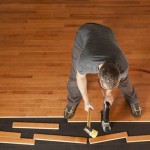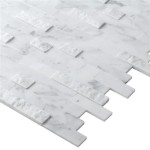Layers of Flooring in a House
Flooring is an essential part of any home, providing a surface to walk on, protecting the subfloor, and adding to the overall aesthetic. There are many different types of flooring available, each with its own unique benefits and drawbacks. The type of flooring that is right for a particular home will depend on a number of factors, including the climate, the amount of traffic the floor will receive, and the budget.
Regardless of the type of flooring chosen, it is important to understand the different layers that make up a floor. These layers include:
- The subfloor: The subfloor is the structural foundation of the floor. It is typically made of plywood or oriented strand board (OSB) and is attached to the floor joists. The subfloor provides support for the flooring material and helps to distribute weight evenly.
- The underlayment: The underlayment is a thin layer of material that is installed between the subfloor and the flooring material. It helps to reduce noise, provide cushioning, and protect the flooring material from moisture. Underlayment can be made from a variety of materials, including cork, rubber, and felt.
- The flooring material: The flooring material is the top layer of the floor and is what is visible when looking at the floor. It can be made from a variety of materials, including hardwood, laminate, tile, and carpet.
- The transition strips: Transition strips are used to cover the joints between different types of flooring materials. They help to create a smooth transition between the different materials and protect the edges of the flooring from damage.
- The baseboards: Baseboards are used to cover the joint between the floor and the wall. They help to hide any gaps between the two surfaces and add a finished look to the room.
By understanding the different layers of a floor, homeowners can make more informed decisions about the type of flooring they choose and how to maintain it properly.
Types of Flooring Materials
There are many different types of flooring materials available, each with its own unique benefits and drawbacks. Some of the most popular types of flooring materials include:
- Hardwood: Hardwood flooring is a classic choice that is known for its beauty, durability, and versatility. It is available in a wide range of species, colors, and finishes, making it a great option for any home.
- Laminate: Laminate flooring is a less expensive alternative to hardwood flooring that is designed to look like wood. It is made from a high-density fiberboard core with a photographic image of wood applied to the top. Laminate flooring is durable and easy to care for, but it is not as long-lasting as hardwood flooring.
- Tile: Tile flooring is made from ceramic, porcelain, or natural stone. It is durable, waterproof, and easy to clean. Tile flooring is a great option for kitchens, bathrooms, and other areas that are prone to moisture.
- Carpet: Carpet is a soft, comfortable flooring material that is available in a wide range of styles and colors. It is a great option for bedrooms, living rooms, and other areas that need a touch of warmth and comfort.
When choosing a flooring material, it is important to consider the climate, the amount of traffic the floor will receive, and the budget. It is also important to think about the overall style of the home and how the flooring will complement the other décor.
Maintaining Your Floors
Regular maintenance is essential to keeping your floors looking their best and lasting for many years to come. The type of maintenance required will vary depending on the type of flooring material, but there are some general tips that apply to all types of flooring:
- Sweep or vacuum your floors regularly to remove dirt and dust. This will help to prevent scratches and other damage.
- Mop your floors with a damp mop to remove dirt and grime. Avoid using harsh chemicals or cleaners, as these can damage the flooring.
- Protect your floors from spills and stains by using rugs and mats. This will help to prevent damage and make it easier to clean up spills when they do occur.
- Avoid wearing shoes with heels on your floors, as this can cause scratches and dents.
- If you have pets, trim their nails regularly to prevent them from scratching your floors.
By following these simple tips, you can help to keep your floors looking their best for many years to come.

Understanding The Layers Of Your Floors All About

Pin Page

Description Of The Structural Layers Spc Flooring Dishover Vinyl Manufacturer Wholesale And Export Worldwide

Laying A Concrete Floor Diy Extra

Floors Types Of Methods Construction Floor

Evolution Of Building Elements

Self Build Design Floor Construction

Floor Framing Structure

Evolution Of Building Elements

Adobe Floor Basics How To Build A Dirt Cheap








